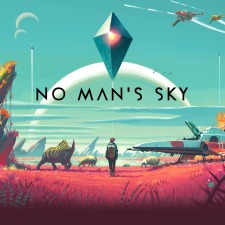 Developer: Hello Games
Developer: Hello Games
First Release: 9th August, 2016
Version Played: PlayStation 4
Available: Amazon.com | Amazon UK | Steam
A traveller wakes up by a shipwreck on an alien world. A message is left for them by an entity called Atlas, and sentinel drones patrol for unknown reasons. It’s time to fix the ship and go exploring.
Procedural generation is the core of this game. Every planet is a bit different. Animals are constructed from putting together basic parts, there are different plant selections, different climates, and so on. The art style looks rather like old science fiction landscape covers. It’s somewhat realistic, but much brighter and bolder.
My first planet was an idyllic world with green almost-grass, reddish-orange trees, and lovely weather. As I woke up next to my broken spaceship, I was told something by the exosuit voice that I couldn’t understand, because the voice is difficult to pick out and it didn’t have subtitles. This fortunately becomes less of an issue after that, as the suit voice is just reinforcing things shown on the screen.

Image Caption: My starting planet. The foreground has green grass, and a larger tree on the right with red-orange leaves. The distance has patches of brown earth and more grass, with a forest stretching into the distance. The sky is a pale green colour. At the top, there’s a black curve, which acts as a compass.
The game prompted me to fix the ship. After a long journey for minerals, and an encounter with angry crabs, I got it done. But I still left the ship behind, as planets are made for walking. This became easier when I realised I could call the ship from certain locations, so I didn’t need to worry that I’d wander too far. I quickly got the hang of the different things I could find, like ruins with alien backstory, and drop pods to upgrade my suit inventory. I looked for new animals on the way, to find all the species on the planet. It is a little strange that I was discovering things on a planet packed with alien outposts, where spaceships were flying above me. These things already had names, and there were logs from travellers who’d been here before me. But my traveller liked to think they were the first to discover it, so I wasn’t going to argue.
Just when I was wondering where I’d find the last few creatures, I had a stroke of luck. As I crested the rolling hills, I spied a flock of majestic penises bouncing along on their testicles. It’s said that players given an open creation tool will always make genitals, but it’s maybe time we cut them some slack. Procedural algorithms are no better. It was also at this point I decided that naming everything after what it resembled was a bad idea.
Eventually, it was time to head into space. This was an odd experience, as space was a thick coloured cloud with asteroids everywhere. The controls were like trying to fly in treacle. Planets were all very close, making it feel more like a pretty menu for the planets than being in space. I do give credit for it being a seamless experience, as I could go from space to the planet’s surface without obvious loading screens. It just didn’t feel like space.
The galactic map, used for jumping between systems, was awkward to use. I really wish it had a cursor I could move over the stars, rather than having to move the sticks around and hope it moved to the star I wanted to view. It’s unlikely I could ever find my way back to systems I’d previously discovered.
After jumping between a few systems, ships would sometimes attack in space, but I still felt like I was selecting planets from a menu rather than flying a ship. The combat was nothing special. There wasn’t any depth in weapon choices, with only two kinds of weapon with a few upgrades. Having to go into the inventory to recharge shields was a pain. All round, space combat was something to do for the game milestones (which also link to trophies), not because it was good.
My early experiences were generally fun. I liked exploring, and it wasn’t too difficult to mine stuff to keep my exosuit running. Inventory space is a little tight at first, but it can be expanded. The biggest issue was the game didn’t want to explain anything. Controls were only shown in a diagram in the options menu and there was no explanation of what icons meant. For example, selecting options requires holding the button, not just pressing it. A red shield icon appears on the screen, but it actually means the inventory is full, not that the shield has a problem. Scanned plants and animals have to be uploaded after scanning to count, and again after all animals are found. There’s no air of mystery in withholding basic game functions from the player. All it meant is I paused the game to search for the answers online, which was time I wasn’t spending playing the game.
As the game continued, I got the hang of the interface, and it was mainly down to exploring. I enjoy mining and exploring in games, so I didn’t mind wandering around looking for animals and gathering resources. It’s a relaxing thing to do. There were a few more exciting moments on planets with threats, which were also fun in their own way. I spent a long time on a planet with sentinels that attack on sight, as part of a set of milestones for surviving on extreme planets. I think the family were a bit boggled as I walked slowly over the landscape and said, “I can’t stop. A killer robot is chasing me.” Sentinels aren’t the fastest robots out there.
Encounters with aliens were mostly rather similar, but there were a few that stood out. There was the time I stuck a killer slug up my nose because of a misunderstanding between “don’t stick this up your nasal passage” and “stick this up your nasal passage”. I’d have liked more of those, and less of aliens needing some basic resource for their equipment. These alien encounters could be a good way of showing how their society is now, in contrast to their ancient history, but the game never really got there.
The planets were the highlight. I found rocky deserts with strange plants and stone pyramids, ocean worlds with swimming eyeballs, and lush planets with plants everywhere. Some things do repeat a little too often, such as there being a limited range of items that grow in caves, and resource items looking the same on most planets. Those zinc flowers are like an invasive species that have found a way to populate nearly every planet in the galaxy. But mostly, I was finding planets that couldn’t have been mistaken for the one before.
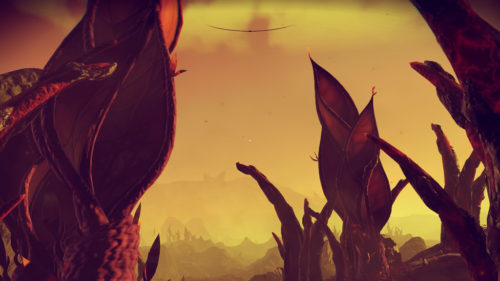
Image Caption: Another planet, which contrasts starkly with my first planet. Giant red leaves twist towards the sky, growing from a bare rock surface. The air is hazy and orange. The compass is visible, and there’s a white dot in the centre which acts as a cursor in the PS4 version.
Animals have areas where the variation really works, such as individuals in a herd varying. They might have babies with them, for example. Some species have very different individuals, to the point that it takes a scan to see they’re the same species. I did get a feel for some of the elements used to make the animals, as some noticeably repeated. Angry crabs were pretty common on the worlds I visited. The range of animal sounds was also small. But I was always finding new things. The best was when a big animal was given tiny butterfly wings, and it flew along like the universe’s most clumpy fairy.
As might be guessed from the clumpy fairy, the biology isn’t realistic. Herbivores can have carnivore teeth or a planet might only have herbivores. Animal behaviour is not very detailed. There were some nice moments though, like the carnivorous cow trying to chase one of the faster herbivores. There’s a good reason why cows aren’t mighty hunters. I’d like to see more of that kind of thing.
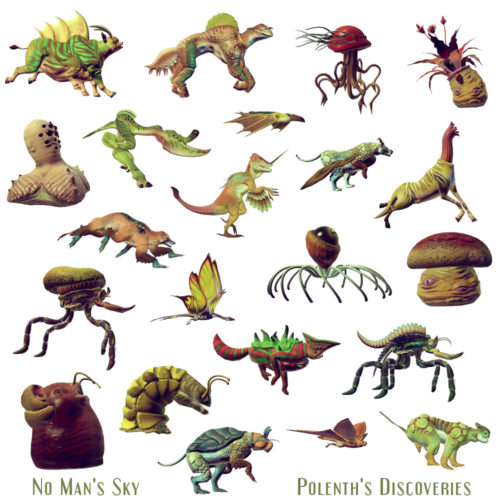
Image Caption: A collage of some of my animal discoveries, showing the range of things found. Animals include a mushroom with eyes on their stalk, a bird with three butterfly wing segments, a biped bird-dinosaur with a unicorn horn on their nose, an eyeball with tentacles, a mite with six legs and a crest on their back, and a green zebra-striped pigcow.
Much as I like exploring, the game promised a story. The strongest point is the lore about the past. Ruins reveal the history of the main alien races. Old logs tell the story of an ancient traveller. Any player can find these by exploring, regardless of other choices.
Things aren’t good when it comes to story where the player participates. The crash site had an item that let me talk to Atlas. This suggested there were two main story paths: helping Atlas and rejecting Atlas. It turns out that wasn’t the case. By rejecting Atlas, I’d opted out of the story, rather than choosing a different story. For those who do follow Atlas, the additional story it unlocks is sparse. There’s also a little bit of information that can be picked up by talking to two other characters, which again, doesn’t add a whole lot.
The game also strongly suggests that getting to the centre of the starting galaxy would be significant. All systems are marked by how close they are to the centre, there are black holes as shortcuts to the centre, and the galactic map really wants to show the player how to get to the centre. But the game sets players up to be disappointed, as it doesn’t follow through on the promise of something special.
The central problem was a lack of satisfying rewards for doing any of these things. That would mean getting a reasonable chunk of story or visiting a unique place. The game could have done with taking a good look at walking simulators. Those games have using story and setting as a reward, often in non-linear ways, down to an art. It’s clear that’s what this game was trying to do, but it didn’t succeed.
There are accessibility issues with the game. The character head movement can’t be turned off. This is particularly a problem as the character sways when standing still, which removes my usual trick of taking a motion sickness break by standing still. Red and green dots are used to mark animals when scanning, which is a colour blindness issue. The dots are also tiny. Making the dots bigger, and putting a symbol in the dots, would make them a lot more usable.
The game has a wide variety of genders for the animals found, including rational, asymmetric, orthogonal, none, and non-uniform. Some aliens are referred to using gender-neutral pronouns. There aren’t any humans, so there isn’t a direct comparison to how well it handles human genders. However, all but one of the trophy descriptions are named after stories by men, which isn’t a good sign in that direction (the exception being short story “Symphony For a Lost Traveler” by Lee Killough).
A concern for how endless the game will be is the design decisions for galaxy creation. My top update would be more types of worlds to explore, more alien races, adding more assets into the pot for the procedural algorithms to use, and other things that mean there will always be more to find. But the universe is already created, so that’s unlikely to happen. It would mean remaking the universe, and destroying people’s discoveries in the process, which I’m sure they won’t do (and I wouldn’t want them to either). I’d have rather the game started out with a single galaxy and had new variations in future galaxies, than to have infinite galaxies that will all be the same.
This is a game that has its extremes. The weak areas, like the story and the space flight, are very weak. The strength is the range of planets produced from the procedural algorithms, which is something unique. It will appeal to anyone who wants to wander alien planets. I loved finding the animals, swimming in the oceans, and naming everything. The main thing is for players to know what they’re getting. Exploring other worlds and seeing strange creatures, for sure. A story that explores the mystery of the setting and great space combat, not so much.
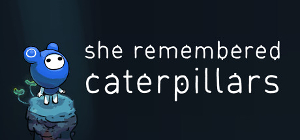 Developer: jumpsuit entertainment
Developer: jumpsuit entertainment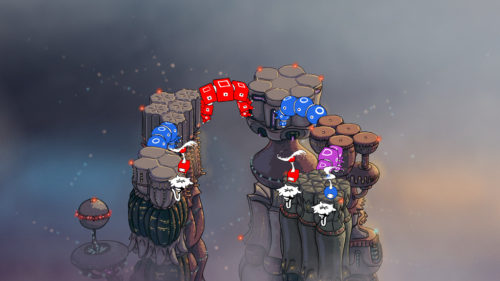
 Developer: WZO Games Inc
Developer: WZO Games Inc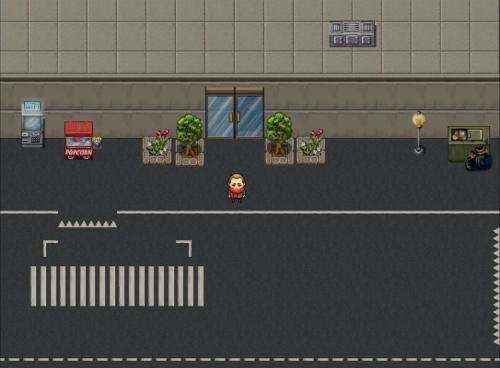
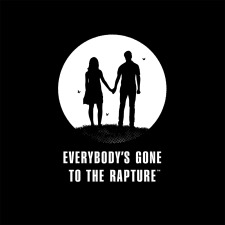 Developer: The Chinese Room
Developer: The Chinese Room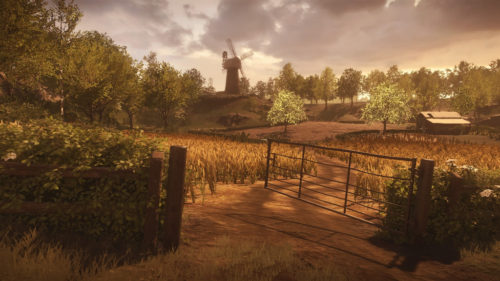
 Developer: Hello Games
Developer: Hello Games


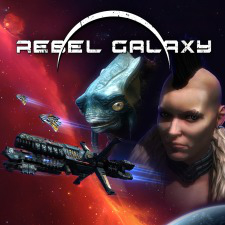 Developer: Double Damage Games
Developer: Double Damage Games